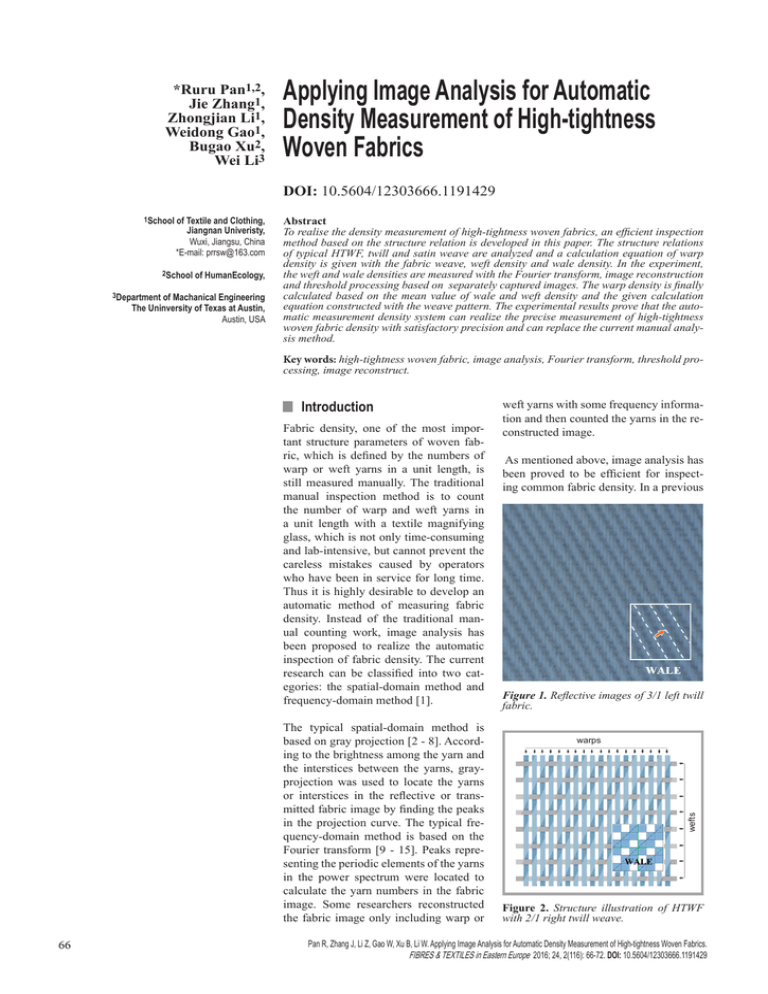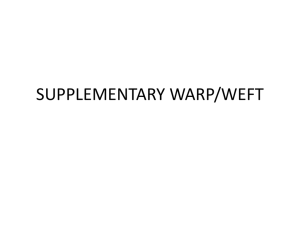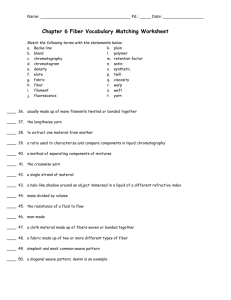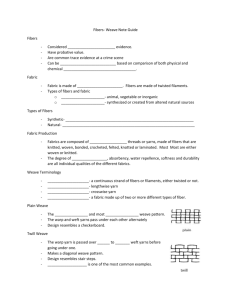Applying Image Analysis for Automatic Density Measurement of High-tightness Woven Fabrics *Ruru Pan
advertisement

*Ruru Pan1,2, Jie Zhang1, Zhongjian Li1, Weidong Gao1, Bugao Xu2, Wei Li3 Applying Image Analysis for Automatic Density Measurement of High-tightness Woven Fabrics DOI: 10.5604/12303666.1191429 1School of Textile and Clothing, Jiangnan Univeristy, Wuxi, Jiangsu, China *E-mail: prrsw@163.com 2School of HumanEcology, 3Department of Machanical Engineering The Uninversity of Texas at Austin, Austin, USA Abstract To realise the density measurement of high-tightness woven fabrics, an efficient inspection method based on the structure relation is developed in this paper. The structure relations of typical HTWF, twill and satin weave are analyzed and a calculation equation of warp density is given with the fabric weave, weft density and wale density. In the experiment, the weft and wale densities are measured with the Fourier transform, image reconstruction and threshold processing based on separately captured images. The warp density is finally calculated based on the mean value of wale and weft density and the given calculation equation constructed with the weave pattern. The experimental results prove that the automatic measurement density system can realize the precise measurement of high-tightness woven fabric density with satisfactory precision and can replace the current manual analysis method. Key words: high-tightness woven fabric, image analysis, Fourier transform, threshold processing, image reconstruct. Fabric density, one of the most important structure parameters of woven fabric, which is defined by the numbers of warp or weft yarns in a unit length, is still measured manually. The traditional manual inspection method is to count the number of warp and weft yarns in a unit length with a textile magnifying glass, which is not only time-consuming and lab-intensive, but cannot prevent the careless mistakes caused by operators who have been in service for long time. Thus it is highly desirable to develop an automatic method of measuring fabric density. Instead of the traditional manual counting work, image analysis has been proposed to realize the automatic inspection of fabric density. The current research can be classified into two categories: the spatial-domain method and frequency-domain method [1]. The typical spatial-domain method is based on gray projection [2 - 8]. According to the brightness among the yarn and the interstices between the yarns, grayprojection was used to locate the yarns or interstices in the reflective or transmitted fabric image by finding the peaks in the projection curve. The typical frequency-domain method is based on the Fourier transform [9 - 15]. Peaks representing the periodic elements of the yarns in the power spectrum were located to calculate the yarn numbers in the fabric image. Some researchers reconstructed the fabric image only including warp or 66 weft yarns with some frequency information and then counted the yarns in the reconstructed image. As mentioned above, image analysis has been proved to be efficient for inspecting common fabric density. In a previous Figure 1. Reflective images of 3/1 left twill fabric. warps wefts nIntroduction Figure 2. Structure illustration of HTWF with 2/1 right twill weave. Pan R, Zhang J, Li Z, Gao W, Xu B, Li W. Applying Image Analysis for Automatic Density Measurement of High-tightness Woven Fabrics. FIBRES & TEXTILES in Eastern Europe 2016; 24, 2(116): 66-72. DOI: 10.5604/12303666.1191429 a) b) c) C C C D D D A E B A E B E A B Figure 3. Three typical twill weaves: a) 2/1 right, b) 2/2 right, & c) 3/1 right. study, we used Fourier transform analysis to successfully measure the density of some common fabrics [16]. But in further experiments, we found that the density of some special fabrics, especially those with high tightness, cannot be correctly measured by the method and instrument proposed. More research will be done in this paper to solve this problem. Compared with common woven fabrics, the density of some special fabrics is hard to measure even with manual analysis, such as fabrics with high-tightness. High-tightness woven fabric (HTWF) is a kind of fabric with high warp or weft tightness, which refers specially to fabric with no apparent interstices between the warp or weft yarns in this paper. A representative HTWF image, the face of 3/1 left twill fabric, is shown in Figure 1. From the figure, it can be seen that even with microscopes or textile magnifying glasses, it is nearly impossible to distinguish and count the number of warp yarns along the horizontal direction. In manual measurement, the operators have to ravel the fabric and then count the yarns to get the warp density, which is more time-consuming and labintensive than for common fabrics. Unfortunately the current image-analysis methods cannot be applied to HTWF either because it is hard to locate warp yarns with the gray-projection method in a spatial-domain or confirm the peaks representing the warp periodic in the frequency-domain. Generally the warp density is much bigger than the weft density in HTWF, such as twill fabric and warp-faced satin fabric, while it is opposite for weft-face satin fabric. In HTWF the floats will form another periodic structure besides the warp and weft yarns, as shown in Figure 2, FIBRES & TEXTILES in Eastern Europe 2016, Vol. 24, 2(116) which will be called ‘wale’ in this research. As seen in Figure 1, the wale density can be more easily measured than the warp density. In previous research [16], we employed a band filter of the Fourier transform to reconstruct a woven fabric image and used an adapted local threshold method to locate the yarns and inspect the density of the woven fabric successfully. Based on the research result, an indirect measurement method of the warp density of HTWF is taken into consideration by analysing the weave pattern and fabric texture in this paper. The rest of this paper is organised as follows. The next section provides an analysis and description of the HTWF and gives the measurement method of the warp density of the HTWF. Experimental results and discussion are described in the following section to demonstrate the efficiency of the measurement method proposed. The final section summarises the content of this paper. blocks are the weft yarn floats. The skew gray lines indicate the wales. As seen in the three figures, AC and BE are two neighbouring parallel wales. The height BD of △ABC is the distance between the two neighbouring wales, AC and BE. The wale density, which is defined as the number of wales in a unit length, Pl = 1/BD. The relationships between the fabric density and weave size are BA = Rj/Pj, BC = Rw/Pw, where Pj & Pw are the warp and weft density, respectively. The area of △ABC is calculated by the following equation: a) C D E A n Measurement methods B Structure analysis of HTWF In this section, we will give an equation to calculate the warp density of HTWF by analysing two typical HTWFs, twill weaves and satin weaves. Twill is a typical type of textile weave, which consists of four important weave parameters: the size of weave repeat unit Rj × Rw and the step number along the warp and weft direction Sj × Sw. It meets the requirements: Rj = Rw ≥ 3 and Sj = Sw = ±1. Three typical twill weaves, including 2/1, 2/2 and 3/1 right twills, are employed to analyze the relationship between the fabric density and weave, as shown in Figure 3. The blue blocks are the warp yarn floats, while the white b) C D A E B Figure 4. Warp-face satin weave pattern; a) 5/2. b) 5/3. 67 D Image acquisition 7) 8) 6) 5) 4) 3) 2) 1) Figure 5. Structure of the fabric density measurement system; 1) transmission light, 2) fabric sample, 3) reflection light, 4) microscope, 5) digital camera, 6) usb data cable, 7) computer, 8) software. BA × BC = AC The structure of the fabric density measurement system used in the experiment is shown in Figure 5. A transmitted light source is used to illuminate the fabric sample and a USB data cable transfers image data to the computer. The density of HTWF is measured with the hardware and software in the computer. As in previous research, a Motic-SMZ 140Z digital microscope is adopted as the hardware for image acquisition [16]. The magnification of the microscope used is 10 - 40 and three kinds of resolution are provided for the measurement: 512 × 384 pixels, 1024 × 768 pixels, and 2048 × 1536 pixels. The magnification and resolution are determined based on the weave structure parameters. The default magnification and resolution are 10 and 1024 × 768 pixels for measuring the density of HTWF. The scale of the captured image in Scale is 0.001785 cm/pixel and the corresponding physical size of image is 1.83 × 1.37 cm. As discussed above, we measure the weft and wale density separately and then calculate the warp density. Two transFigure 6. Fabric images of sample 1; a) wale, b) weft. mitted images of Sample 1, a 3/1 right twill fabric, are captured by the system 1 1 1 the measurement method 2 2 2to demonstrate S∆ABC = BD × AC = BA × BC (1) (1/ BA) + (1/ BC ) = ( Pj / R j ) + ( Pw / Rw ) 2 Pl == shown in Figure 6. The physical size of 2 2 BD (3) the width (along the horizontal direcBA × BC BA × BC 1 BD is calculated as follows: = BD = = tion) is 1.83 cm and that of the height AC BA2 + BC 2 (1/ BA) 2 + (1/ BC ) 2 BA × BC BA × BC 1 (along the vertical direction) is 1.37 cm. = BD = = AC Figure 6.a is used to measure the wale BA2 + BC 2 (1/ BA) 2 +If (1/ BC ) 2 weave pattern is known and the (2) density for the wales in the vertical direcBA × BC 1 the weft and wale densities P & P are w l = measured by the digital image processing tion, while Figure 6.b is used to measure BA2 + BC 2 (1/ BA) 2 + (1/ BC ) 2 method, Pj can be calculated by the fol- the weft density for the wefts in the vertiPl is then calculated as: cal direction. lowing equation: Pj = Fabric image Fourier transform Filter in the frequency-domain Reconstruction fabric image Threshold process Density measurement Figure 7. Measurement flaw chart of weft and wale density measurement. 68 ( Pl × R j ) 2 − ( Pw × R j / Rw ) 2 (4) Satin is another typical type of textile weave which meets the requirements: Rj = Rw ≥ 5, 1 < S < Rj - 1, and both Rj and S are prime numbers, where S is Sj or Sw. When Satin is warp-faced, S is Sj, and when Satin is weft-faced, S is Sw. Satin weave is often designated as R/Sj warpfaced satins or R/Sw weft-faced satins. Illustrations of the 5/2 and 5/3 warp-face satin weave pattern are shown in Figure 4 (see page 67) In the satin weave BA = Rj/Pj/Sj, Sj is the step number along the warp direction. Therefore the calculation equation of Pj in Equation 4 is then modified as the following equation: Pj = ( Pl × R j / S j ) 2 − ( Pw × R j / S j / Rw ) 2 (5) Wale and weft density measurement The previous work is adopted to realise the wale and weft density measurement, and the flaw chart is shown in Figure 7 [16]. The captured fabric image is first transformed into a frequency-domain with Fourier transform. A band filter is then selected to filter the frequency signals and reconstruct the fabric image only including the wales or wefts. A local adaptive threshold method, Niblack’s threshold, is chosen to process the reconstructed fabric image with a local window size, 32 × 32 pixels. In the binary image, a standard line is traversed from left to right and the density of the wale or weft is then measured. Inspection of the wale density of sample 1 is carried out in following steps to FIBRES & TEXTILES in Eastern Europe 2016, Vol. 24, 2(116) N Pl (6) (EP - SP + 1)×Scale a) where, Pl is the density of the wale or weft, N the number of wale or weft, SP the coordinate of the Start Point, and EP is the coordinate of the End Point. Figure 8. Reconstructed image of weft yarns. describe the measurement processes of the wale and weft density of the HTWF, the results of which are shown in Figure 8. Step 1: The colour fabric image is converted into a gray image and transformed into a frequency-domain with the Fourier transform. The amplitude spectrum of sample 1 after the frequency shift is then obtained as shown in Figure 9.a. Step 2: A template-based filter is then applied to the frequency signals and a band including periodic information of the wales is kept as a black rectangle in Figure 9.a. In our experiment, seven lines of frequency signals in the center are preserved after the filtering process. Step 3: The frequency signals preserved are used to reconstruct a fabric image with the inverse Fourier transform. The reconstructed fabric image is shown in Figure 9.b, which only includes wale information, represented as blacker pixels. Step 4: The reconstructed fabric image is changed into a binary image with Niblack’s threshold method as shown in Figure 9.c. The black pixels indicate the positions of wales, while the white represent the those of the interstices between the wales. Step 5: A standard measurement line is adopted to traverse from left to right in order to find the number of whole wales, including the wale and interstice, as shown in Figure 9.c. The coordinates of the “Start Point” and “End Point” labelled in Figure 9.c are used to calculate the density as Equation 6 with the wale or weft number. The scale is the magnification value of the fabric image. FIBRES & TEXTILES in Eastern Europe 2016, Vol. 24, 2(116) In the measurement of the wale density of sample 1, N is 27, EP - 1005, SP - 11, and Scale is 0.001785 cm/pixel. Pl is calculated with results of 15.2 threads/cm. b) In order to measure the wale density precisely, the wales should be put in the vertical direction when capturing the fabric image. As discussed in [16], in the density measurement system, the reconstructed fabric image can be selected to display, which can help the operator find the wales. The operator can click the density measurement button after he sees the reconstructed wales are in the vertical direction in the reconstructed fabric image, as in Figure 9.b. c) start point The density of weft yarns can be measured with a similar process. Figure 8 shows the reconstructed fabric image of sample 1, as shown in Figure 6.b, only including the wefts after threshold processing. The number of weft yarns is counted and the weft density automatically calculated according to Equation 6. The weft density of sample 1 is 22.2 threads/cm. Figure 9. Measurement processes of wale density; a) amplitude spectrum of fabric image, b) reconstructed fabric image, c) binary image and standard measurement line. Warp density measurement for each sample and mean values adopted to calculate the warp density in order to reduce the measurement error caused by unevenness of the yarn arrangement in the fabric. After measurement of the wale and weft density, the warp density Pj of sample 1, a 3/1 right twill fabric, can be calculated according to Equation 5 using the following equation. Pj = n Results and discussion (7) = 56.6 threads/cm end point A comparison of fabric density by manual and automatic measurement is first demonstrated. In the manual operation, the weft density is inspected by counting the wefts in a unit length with a textile magnifying glass, and the warp density is measured by raveling the fab- To demonstrate the measurement process, the wale and weft density of HTWF are only inspected once. In the automatic density measurement system, the wale and weft density are measured ten times Table 1. Density comparison of fabric sample 1 by manual and automatic measurement. Mean Standard deviation 15.0 15.5 15.5 15.5 14.5 15.0 15.0 14.5 15.5 15.0 15.1 0.37 22.0 22.5 22.0 22.0 22.0 22.5 22.5 22.5 22.5 22.0 22.3 0.25 Wale 15.2 15.3 15.4 15.1 15.3 15.0 15.3 15.1 15.3 15.1 15.2 0.12 Weft 22.2 21.8 21.7 22.3 21.9 22.4 22.5 22.4 21.8 22.0 22.1 0.28 Method Times Manual measurement (thds/cm) Weft Warp Automatic measurement (thds/cm) 1 2 3 4 5 6 7 8 9 10 69 a - 2) b - 2) c - 2) d - 2) a - 3) b - 3) c - 3) d - 3) a - 4) b - 4) c - 4) d - 4) a - 5) b - 5) c - 5) d - 5) a - 6) b - 6) c - 6) d - 6) a - 7) b - 7) c - 7) d - 7) Figure 10. (Presented on page 70 and 71). HTWF images and corresponding reconstructed binary images; a) wale image, b) reconstructed binary wale image; c) weft image, d) reconstructed binary weft image; (eg: a-2 represents the wale image of sample 2; b-2 represents the reconstructed binary wale image of sample 2). ric and counting the warps in a unit length. The automatic method measures the wale and weft densities ten times and calculates the mean values, with the warp density then calculated according to Equation 5. To validate the results, the manual operations are also done ten times. The experiments of the method are carried out with a density measurement system programed by Borland C++ 6.0. The computer doing the experiments is equipped with the Win7 Ultimate Sys- 70 tem, CPU Intel® Core™i3 and 2.00 GB memory. The inspection regions are chosen randomly in the fabric. The results are listed in Table 1 (see page 69). The differences among the measurement data result from the uneven yarn arrangement of the fabric. Table 1 shows that the mean value of weft density measured automatically is same as the value measured manually after ten measurements. However, the standard deviation of au- tomatic measurement is less than that of manual measurement, which means that the density inspection results of manual measurement vary more than those of automatic measurement. The reason is that the precision of the manual operation is 0.5 threads in each measurement, while it is 1 pixel in our measurement system. The standard deviation of warp density measured manually is 0.25, which can also prove that the automatic measurement can achieve a more reliable result. FIBRES & TEXTILES in Eastern Europe 2016, Vol. 24, 2(116) a - 8) b - 8) c - 8) d - 8) a - 9) b - 9) c - 9) d - 9) a - 10) b - 10) c - 10) d - 10) a - 11) b - 11) c - 11) d - 11) a - 12) b - 12) c - 12) d - 12) a - 13) b - 13) c - 13) d - 13) Figure 10 (Continuation from page 70). HTWF images and corresponding reconstructed binary images; a) wale image, b) reconstructed binary wale image; c) weft image, d) reconstructed binary weft image; (eg: a-2 represents the wale image of sample 2; b-2 represents the reconstructed binary wale image of sample 2). The warp density can be calculated automatically with the mean values of wale and weft density according to Equation 5. The result is 64.8 thds/cm, which is same as with the manual operation. Nevertheless the automatic method only takes less than 15 seconds to measure the fabric density each time, including the image-capture cost and computing time, while the manual method takes more than 10 minutes. To FIBRES & TEXTILES in Eastern Europe 2016, Vol. 24, 2(116) get a more reliable result with the automatic measurement system, the wale and weft density can be measured with different regions in the fabric to eliminate the effect caused by the unevenness of the fabric. Furthermore the densities of the other twelve different HTWF samples with the different weave patterns, including 2/1 twill, 3/1twill, 5/2 satin and 5/3 satin, which are labelled as Samples 2-13, are measurement to illustrate the effectiveness of the automatic measurement system. The sample images and their corresponding reconstructed binary images are displayed in Figure 10 (page 70 and 71). The weft and wale densities of each sample are measured ten times with the automatic density measurement system. The mean values of weft and wale densities are then computed to calculate the warp density. The measurement 71 Table 2. Density comparison of fabric samples 2 - 10 by manual and automatic measurement. Sample Weave pattern 2 Manual measurement, thds/cm Error, % Weft Warp Wale Weft Warp Weft Warp 2/1twill 29.0 48.0 18.7 28.8 48.1 0.69 0.30 3 2/1twill 29.0 51.5 19.7 29.0 51.8 0.00 0.53 4 2/1 twill 45.0 58.0 25.1 45.1 57.7 0.22 0.52 5 2/1 twill 30.0 58.5 21.8 30.0 58.1 0.00 0.66 6 2/1twill 24.0 62.5 23.8 35.2 62.1 0.57 0.61 7 3/1twill 23.0 44.5 12.6 23.0 44.8 0.00 0.78 8 3/1 twill 28.0 83.5 22.0 28.2 83.4 0.71 0.17 9 3/1 twill 23.5 47.5 13.2 23.5 47.3 0.00 0.46 10 3/1twill 31.0 68.0 18.6 31.3 67.5 0.97 0.74 11 5/2 satin 31.5 71.0 29.0 31.8 70.7 0.95 0.37 12 5/2 satin 41.0 83.0 34.2 40.5 83.1 1.22 0.08 13 5/3 satin 44.5 78.0 47.4 44.3 77.6 0.45 0.50 results are listed in Table 2. To show the precision degree of the automatic method, the manual operation is also carried out for each sample three times. The weave patterns of the fabric samples include 2/1, 3/1 twill weaves and 5/2, 5/3 satin weaves. Comparing the automatic measurement results to those of manual measurement, it can be seen that the results are almost the same, with a maximum error of 1.22% (weft density of sample 12). The error mainly results from the different measurement regions selected for density inspection and the measurement precision. From the measurement results, it is concluded that automatic density measurement can be used to replace the current manual density measurement method for HTWF. The density measurement system can achieve the aim of saving operation time and reducing the labintensity of the operators. With the measurement system proposed, the density of HTWF can be inspected automatically. The reconstructed image of wales or wefts can help operators determine the position of the fabric. The operator simply needs to select the weave pattern and different regions in the fabric to complete the density measurement, which is much faster and more convenient than the current manual method. nConclusions In this paper, image analysis is proposed to realise the density measurement automatically for the HTWF. The structure of the HTWF is first discussed and a calculation equation of the warp density is presented. The wale and weft densi- 72 Automatic measurement, thds/cm ties are measured with following steps: 1) Fourier transform of the fabric image, 2) filter in the frequency-domain and reconstructed fabric image, 3) threshold processing, 4) count the number of yarns or wales and measure the density. The warp density is finally calculated based on the mean value of wale and weft density and the given calculation equation. Experimental results proved that the method proposed can realise precise measurement of solid colour HTWF density. The density measurement system can replace the current manual analysis method with human vision. Acknowledgements The authors would like to acknowledge the National Natural Science Foundation of China (No. 61202310), Research Fund for the Doctoral Program of Higher Education of China (20120093130001), the Henry Fok Educational Foundation (141071), the National Postdoctoral Fund Project (2013M541602), the Postdoctoral Fund Project of Jiangsu Province (1301075C), Prospective Industry University Research Project of Jiangsu Province BY2013015-20. References 1. Technikova L and Tunak M. Weaving density evaluation with the aid of image analysis. Fibres and Textiles in Eastern Europe 2013; 21(2): 74-79. 2. Jeong Y J and Jang J H. Applying image analysis to automatic inspection of fabric density for woven fabrics. Fibers and Polymers 2005; 6(2): 156-161. 3. Lachkar A, Gadi T, Benslimane R, D’Orazio L and Martuscelli, E. Textile woven-fabric recognition by using Fourier image-analysis techniques: Part I: a fully automatic approach for crossed- points detection. Journal of the Textile Institute 2003; 94(3-4): 194-201. 4. Pan RR, Liu JH and Gao WD. Measuring linear density of threads in singlesystem-mélange color fabrics with FCM algorithm. Color Research & Application 2013; 38(6): 456-462. 5. Pan R R, Gao W D, Liu J H and Wang H B. Automatic inspection of woven fabric Density of solid colour fabric density by the Hough transform. Fibres and Textiles in Eastern Europe 2010; 18(4): 46-51. 6. Xiao Z T, Nie X X, Zhang F and Geng L. Recognition for woven fabric pattern based on gradient histogram. Journal of the Textile Institute 2014; 105(7): 744-752. 7. Zhang J, Pan RR and Gao WD. Automatic inspection of the density in yarndyed fabric by utilizing fabric light transmittance and Fourier analysis. Applied Optics 2015; 54(1): 966-972. 8. Zhang J, Xin B and Wu X. Density measurement of yarn dyed woven fabrics based on dual-side scanning and the FFT technique. Measurement Science and Technology 2014; 25(11): 110957110233. 9. Xu B G. Identifying fabric structures with fast Fourier transform techniques. Textile Research Journal 1996; 66(8): 496506. 10.Tunak M, Linka A and Volf P. Automatic assessing and monitoring of weaving density. Fibers and Polymers 2009; 10(6): 830-836. 11. Yu X, Xin B, Gerrge B and Hu J. Fourier analysis based satin fabric density and weaving pattern extraction. Research Journal of Textile and Apparel 2007; 11(1): 71-80. 12.Escofet J, Millán M and Ralló M. Modeling of woven fabric structures based on Fourier image analysis. Applied Optics 2001; 40(34): 6171-6176. 13. Ralló M, Escofet J and Millán M. Weaverepeat identification by structural analysis of fabric images. Applied Optics 2003; 42(17): 3361-3372. 14.Potiyaraj P, Subhakalin C, Sawangharsub B and Udomkichdecha W. Recognition and re-visualization of woven fabric structures. International Journal of Clothing Science and Technology, 2010; 22(2-3): 79-87 15.Mourssa A, Dupont D, Steen D and Zeng X. Structure analysis and surface simulation of woven fabrics using fast Fourier transform techniques. Journal of the Textile Institute 2010; 101(6): 556-570. 16.Pan R, Gao W, Li Z, Gou J, Zhang J and Zhu D. Measuring thread densities of woven fabric using the Fourier transform. Fibres and Textiles in Eastern Europe 2015; 23(1): 35-40. Received 09.06.2015 Reviewed 28.07.2015 FIBRES & TEXTILES in Eastern Europe 2016, Vol. 24, 2(116)







